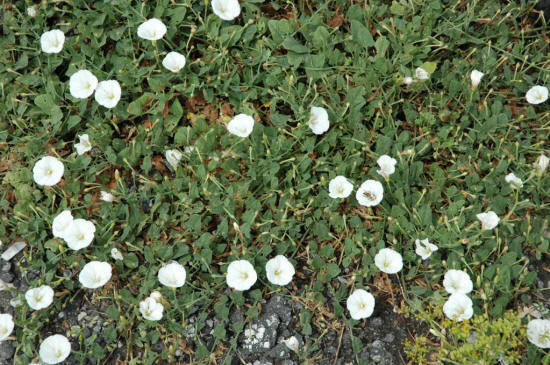|
 Managing
Weeds in the Garden Managing
Weeds in the Garden
By Melinda Myers
 Send a link to a friend
Send a link to a friend
[June 28, 2024]
No matter the weather, weeds seem to thrive and
reproduce, and if left unchecked, they can overwhelm the garden and
gardener. These unwanted plants find their way into your garden as
seeds, roots, rhizomes, or whole plants. Seeds can be carried in by
the wind, birds, and other animals, or on the soles of shoes. Roots,
rhizomes, and even plants hitch a ride in the soil or with plants
that we move into the garden.
|
|
 Start
early managing weeds in your garden. Smaller weeds are easier to
pull and removing them before they flower and form seeds can prevent
hundreds of weeds in next year’s landscape. Start
early managing weeds in your garden. Smaller weeds are easier to
pull and removing them before they flower and form seeds can prevent
hundreds of weeds in next year’s landscape.
This is not always possible. Weather and busy schedules often limit
gardening time, allowing these vigorous plants to overtake the
garden.
It is never too late and worth investing time in managing weeds in
the garden. Weeds are adaptable and vigorous, outcompeting your
desirable plants for water and nutrients. Many serve as host plants
for insect pests and diseases that may also attack your garden
plants.
Carefully dig or pull weeds, removing the top and roots. Established
weeds may have a deep tap root or extensive root system that may be
difficult to remove. Depending on the weed, any part left behind has
the potential to start a new plant.

Find the tool that best works for you. A Dutch or
action hoe works well on small weeds where there is space between
plants. Glide the cutting edge just below the soil surface to cut
the roots. Many gardeners find a weed knife to be a useful tool. It
allows you to dig right next to the weed and pop it out of the
ground with minimal impact on surrounding plants.
If bending is an issue, you may opt for one of the standup weeders.
There are several types available. Most have tines you insert into
the soil surrounding the weed. A hand or foot-operated action causes
the tines to tighten around the weed roots before you lever it out
of the ground.

Perennial weeds are a bit more challenging. Many have
extensive roots that are nearly impossible to remove entirely.
Repeatedly digging up the plants can eventually manage these weeds,
but it can take years. Cutting the plants back to the ground as soon
as they appear can help “starve” them, prevent reseeding, and help
contain and even eliminate some perennial weeds.
[to top of second column] |

If the weeds begin to take over the garden, tackle
those flowering or setting seeds first. Do not compost these or
perennial weeds. Most compost piles don’t get hot enough to kill the
seeds or perennial weeds. Contact your local municipality to find
out your options for disposing of these as well as perennial and
invasive weeds.
Once the weeds are out of the garden, spread a layer of organic
mulch over the soil surface. The finer the mulch, the thinner the
layer needed. Pull the mulch away from tree trunks, shrub stems, and
the crowns of your other plants.
Mulching helps suppress weeds by reducing seed sprouting and making
it easier to pull the seedlings that get through the mulch. Increase
your success by placing a couple of sheets of newspaper or a piece
of cardboard beneath the mulch. Mulching won’t stop existing
perennial weeds like quackgrass and bindweed. Keep managing these
until all the roots have been removed.

Shredded leaves, evergreen needles, and other organic
mulch also conserve moisture, moderate soil temperatures, and add
organic matter to the soil as it breaks down. Mulch also helps
protect the soil from compaction and erosion during heavy rains. As
many places experience more intense rainfall and higher-than-normal
summer heat, mulching the soil becomes even more beneficial.
Consider the benefits when you head out to tackle the weeds in your
garden. You will improve the health and beauty of your garden while
burning between 200 and 400 calories every hour you weed.
Melinda Myers has written over 20 gardening books,
including Midwest Gardener’s Handbook, 2nd Edition and Small Space
Gardening. She hosts The Great Courses “How to Grow Anything”
instant video and DVD series and the nationally syndicated Melinda’s
Garden Moment radio program. Myers is a columnist and contributing
editor for Birds & Blooms magazine. Myers’ website is
www.MelindaMyers.com.
[Photo courtesy of MelindaMyers.com] |